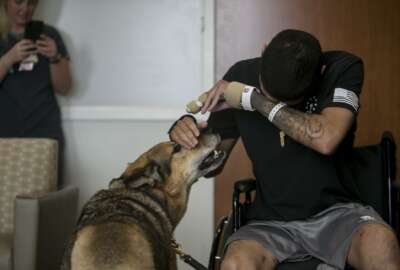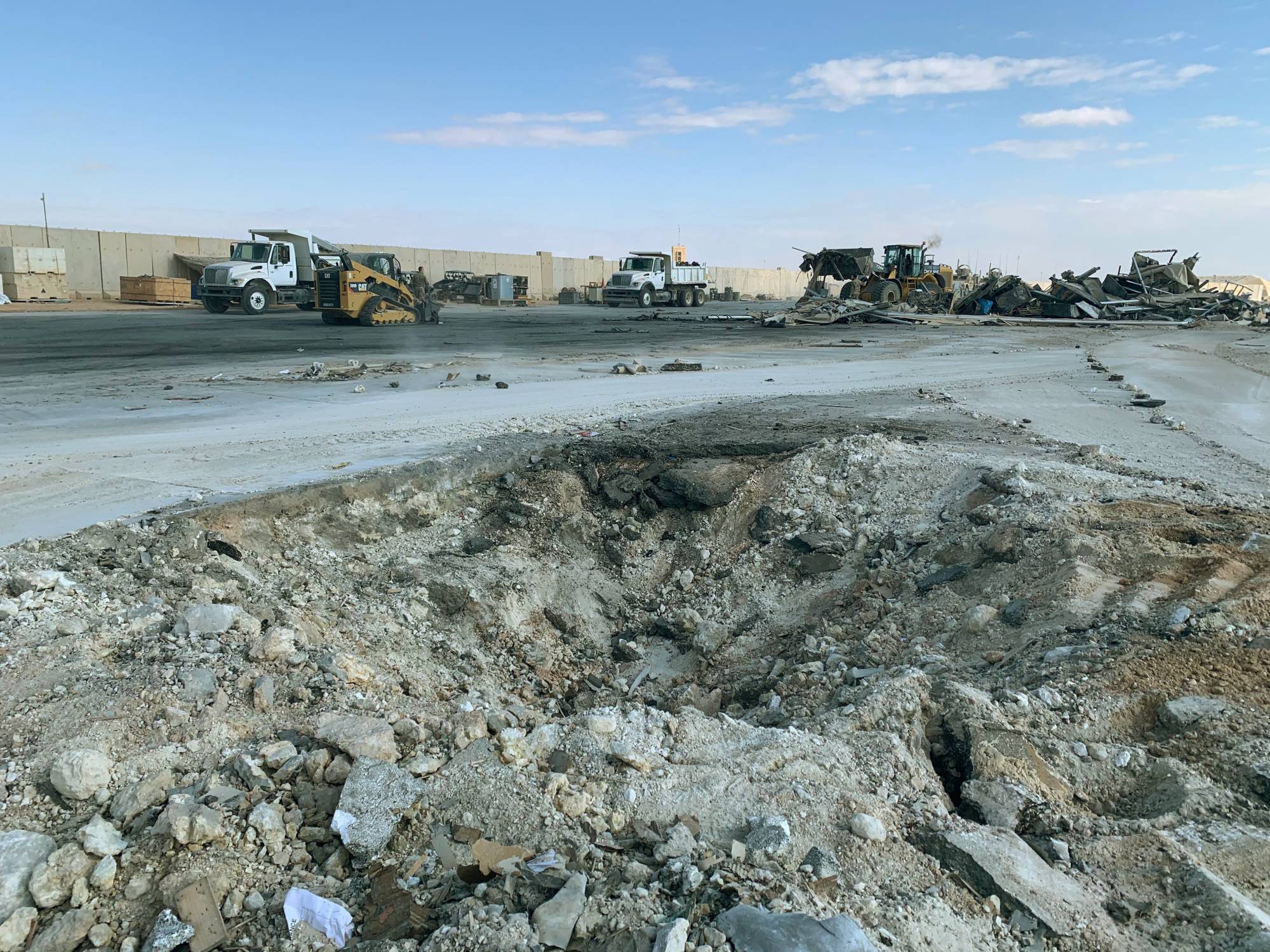Hubbard Radio Washington DC, LLC. All rights reserved. This website is not intended for users located within the European Economic Area.
Defense health officials expand research into traumatic brain injury
Brain injury, whether sustained at a test firing range or in battle, has long been a priority for the Defense medical system. The Warfighter Brain Health Initia...
Brain injury, whether sustained at a test firing range or in battle, has long been a priority for the Defense medical system. The Warfighter Brain Health Initiative this year has boosted its research efforts on service members cognitive abilities and how certain events can threaten it. For an update, the Federal Drive with Tom Temin spoke with the Director of Warfighter Brain Health Policy, Kathy Lee.
Interview Transcript:
Tom Temin Brain injury. Traumatic brain injury has long been a focus, obviously, of defense health programs. But you now have this Warfighter Brain Health initiative something new. Tell us what you’re trying to accomplish here.
Kathy Lee Sure, sure. So, the department’s top priority is to take care of our people, which includes promoting brain health and countering traumatic brain injury. And as you just mentioned, we’ve been a world leader in the area of traumatic brain injury or TBI, care and research. And as we’ve been since the beginning of the Afghan and Iraqi conflicts, and during that time, we really noticed that we needed to expand our efforts beyond just injury, but to expand those efforts to look at brain threats. And that’s really how the Warfighter Brain Health Initiative, or WBHI, was born. This is a real thing. It’s a joint effort between operational and medical forces. And its focus is really to optimize brain health. And we are looking at brain health through the lens of optimizing cognitive and physical performance. So, we’re really looking at thinking skills that’s very important for warriors, warfighters, service members. And so, we have a big focus on that and how it gets impacted by threats in the environment such as blast overpressure, training with munitions and such. And then all the things that we’re doing related to traumatic brain injury is now under this umbrella of warfighter brain health, so that we can maximize coordination efforts across the department.
Tom Temin And relative to some of the earlier issues that you continuously deal with, that is injuries in battle from concussions or shots or whatever the case might be. This sounds like it kind of brings together a whole bunch of concerns, including what can happen in training, in firing not even live rounds, but nevertheless, there’s a blank which is right next to the soldier or the airman’s head, whatever the naval person’s head. What are some of the other factors of brain threat that you need to look at?
Kathy Lee Firing munitions and training. The training environment is one that that we really have, an acute focus on right now and awareness to so that we can, understand better the health and performance brain effects from firing various weapons, either, as you mentioned, live fire or in training scenarios. So, what we’re really trying to get after is three things. We want to be able to monitor that brain threat. We want to be able to document the brain threat, and we want to instill safety and mitigation efforts to try to avoid unnecessary blast exposures as the threat we’re talking about right now. But there’s other threats we’re looking at, too, such as, you know, repetitive head impacts and other things that can really, have some type of impact on to your brain health based on what you’re doing in an operational environment.
Tom Temin Is there a way to monitor and measure what is going on without having an actual brain subjected to it? That is to say, if a particular, say, shoulder fired weapon produces a certain concussive and sound proportion, that’s measurable, can you see what it does to a bowl of Jello, for example, instead of what’s happening with someone real?
Kathy Lee So we’ve just completed, a pretty large initiative over the last 4 to 5 years. The congressionally mandated initiative, actually, where we looked, we did multiple studies looking at what the health and performance effects are. There have been numerous. What you’re describing is pre-clinical, not using human beings, but rather pre-clinical studies that have looked at what the effects can be on the brain tissue, on in the blood and looking at different areas within the blood. And then in our human studies, looking at the symptoms and how it’s affecting the person from in this case, again, blast overpressure. But it is noteworthy that the Warfare to Brain Health Initiative is not just looking at blast as a brain threat, but other initiative, other things within our operating environment in the U.S. military that could have effects on brain health. And so, we’re very astute and attuned to those.
Tom Temin What are some of those.
Kathy Lee So repetitive head impacts? That’s another area. If you are getting your head hit many times from jumping out of, airplanes and various other maneuvers, we’re also looking at other threats, such as, directed energy threats and things that could affect the central nervous system based on that. So, and we’re also looking for emerging threats, things in a future fight, future warfare that may end up impacting brain health in training environments or through enemy action.
Tom Temin And a few years ago, I was reading about brain health in respect to NFL players. And sometimes there is damage that can only be discerned through an autopsy when the person is deceased, and they section the brain and so forth. Have there been advances in the ability to measure the brain of a living person, such that you can maybe get a finer grained sense of what’s going on with someone than we could in the days when you had to section a deceased person’s brain.
Kathy Lee Sir, a great point. I’m looking at the long term and late effects from both repetitive exposures and numerous injuries. Is one of our lines of effort. It’s actually line number four in our plan. So, we have a lot of activities and we are accelerating for exactly that purpose that you just said is not to wait until somebody’s deceased and you’re looking at postmortem tissue, but rather trying to see how we can signal this early on and therefore intervene and be able to provide some treatments. So that’s a very active line of research. I can’t tell you today that we have that for somebody. You know, we’re still looking at those brain tissues and understanding, but we are looking at some novel and some other novel ways to be able to pick that up in living folks.
Tom Temin We’re speaking with Kathie Lee, director of Warfighter Brain Health Policy in the office of the Assistant Secretary of Defense for Health Affairs. And what are some of the ways.
Tom Temin That you measure people through these series of tests and say, what’s going on in the environment? You mentioned there is a performance issue, a cognition issue, and then that might be distinct to some degree from whatever might be the pathological issue. And what are some of the measures of the cognition and performance that don’t involve looking at tissue?
Kathy Lee Great question. So, as I have pointed out, cognition or thinking skills is the main industry right now that we’re looking at for brain health. So, are you brain healthy? We’re looking at your cognition and we’re really trying to get that on par. As people know, physical performance is very highly into our culture in the military, and we are working to get the cognitive thinking parts to be on par with that physical performance. So that being said, the cornerstone of this program of warfare into brain health for the department is a cognitive monitoring program. So, we are beginning this summer to perform a cognitive test. We’ve been performing cognitive tests since 2008 on all those that we’re going to redeploy. And now we’re expanding that requirement to perform a cognitive testing on everybody in the military every five years. So that will be our benchmark to baseline cognition. And that provides us the opportunity to either enhance it and improve it, or even to restore it if it’s been decremented by some of these brain threats that we’ve been talking about.
Tom Temin Do you ever look at since, given the population that tends to populate the military at the training and infantry and naval warfare and frontline levels, young people, mostly young men, but young women now increasingly. And the effect of having their ears plugged with music all the time, to a greater extent than anyone in human history, as maybe adding a little bit of marginal effect on what they’re getting in training.
Kathy Lee So interesting that you ask that question, because the initial military training space is exactly where we’re starting with the cognitive monitoring program. So I can’t answer your question about the music and, at that per se, but we are going to be starting that program, as I mentioned, next summer or this summer, 2024, with the initial military training sites, so that we can ascertain baseline cognitive measures as you enter into the military. And then again, we’ll get the rest of the force so that we can ensure we have a baseline on everybody. That includes the guard and the reserve components as well. And every five years that’ll be checked for that intervention time so that you can either enhance to restore it.
Tom Temin And do you exchange information or testing methodologies or, or data with, say, organizations like the NFL or the NHL or, I don’t know, worldwide wrestling entertainment.
Kathy Lee So we have a very productive and long-standing relationship with the NCAA that has probably been our one of our prime partners in this, in this, inquiry and endeavor to look at brain health and exposures. As I mentioned earlier, we look at sports related concussion and repetitive head impacts. So that is another threat as well. So, we have partnered very, nicely, and effectively with the NCAA. We do have some, some work that we’ve done with the NFL, through this over 20 years of really leading the world in traumatic brain injury related, research and care.
Tom Temin And is there a feedback mechanism for what you’re learning to say, the people that develop training doctrine. Or to the people that develop the uniforms, the head protection, whatever baffles might be on weapons, that kind of thing as well.
Kathy Lee Yes. The train. So, this this really takes a big community throughout the department and partnerships with other federal agencies, with industry, academia. It really does take a true partnership. I’ve already alluded to one with the NCAA. Within the Department of Defense, we traverse this plan goes across more than 16 different areas within the Department of Defense. So, we work closely with our safety offices, the operational units, Special Operations Command, explosive Ordnance disposal. So various places, our clinical communities, our education, and training as well. So, we are tightly yoked with the, the trade community. Ensuring that we’ve got some curricula and training that reflects what these best practices and what we’re learning. But I want to also mention that the single source of information for warfare, brain health can be found at the Warfighter Brain Health Hub, which is in health.mil/brain. So that is the one stop shop, if you will, for all the things that we’re learning related to research, clinical care, operational low level blast exposure. I could go on and on. But health.mil backslash brain is the single source of information for warfighter brain health.
Copyright © 2024 Federal News Network. All rights reserved. This website is not intended for users located within the European Economic Area.
Tom Temin
Tom Temin is host of the Federal Drive and has been providing insight on federal technology and management issues for more than 30 years.
Follow @tteminWFED
Related Stories
VA develops a new program for helping veterans recover from traumatic brain injury
On DoD

WEDNESDAYS, 11 A.M. & 2 P.M.
Each week, Defense Reporter Jared Serbu speaks with the managers of the federal government's largest department. Subscribe on PodcastOne or Apple Podcasts.





